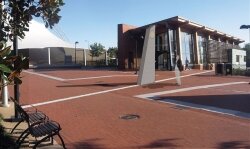Noon mark: Mall to get new $25,000 clock, sundial
Back in August 2009, the City launched a design contest for the creation of a clock on the Downtown Mall to honor Charlottesville's relationship with its three Sister Cities and cost less than $25,000. Since then, a couple of things have changed: we've added another Sister, and it appears the clock will actually get built.
If you're having trouble keeping track, the Sister cities are Besançon, France; Pleven, Bulgaria; Poggio a Caiano, Italy; and the newcomer, Winneba, Ghana.
At the time of the contest announcement, officials weren't sure if the winning design would be built, a reminder of the 2007 taxpayer-funded $150,000 design contest to generate ideas for the development of the Water Street parking lots where nothing was ever built.
In November 2009, a jury of architects, artists, and business people selected a winning clock: a 12-foot-tall granite obelisk called the "Meridian Clock." Envisioned by local designer Edward P. Smith and headed for a location between the Transit Center and City Hall, it would include various timepieces including a noon mark, a simple sundial to note each day's noon.
"I'm an amateur astronomer and geographer," says Smith, who took home the $1,500 prize. "That summer I had been messing around with types of noon marks and using the sun to find True North when I happened to read about the competition. I thought, 'This could work.'"
In addition to second- and third-place designs by Paul Tassell of the Gaines Group and Michael Stoneking, who received $1,000 and $500 respectively for their efforts, there was also a '"people's choice" award winner by a trio of local designers–- Bill Hess, Jim Respess, and Bob Anderson–- selected after a public viewing at City Space. That one would have included four video screens showing real-time images from the four Sister Cities. Tassell's design featured a clock high atop a slim brick tower across from the Landmark hotel site, while Stoneking's clock topped a stout kiosk. There were ten entries in all.
Two and a half years ago, Neighborhood Development chief Jim Tolbert suggested that construction costs could be covered by "left-over Downtown Mall re-bricking funds." Last month, however, City Council decided to build Smith's clock with $25,000 Tolbert now says will come from a percentage of the city's public art account.
The Meridian Clock will be placed on a meridian line, a one-foot-wide strip of granite built into the brick surface that will run true North and South, all the way from the stairs of the Transit Center to a planting bed near the entrance to City Hall. It will operate like a sundial that marks winter and summer solstices, spring and fall equinoxes, and months of the year. There will also be two electric analog clocks embedded atop what Smith calls a "decidedly modern" and "deceptively simple" obelisk.
The structure will include seals identifying the Sister Cities, but it's the solar-powered "teaching tool" aspect that seems to thrill Smith most.
"I'm very excited," he says. "While public sundials are fairly common, as far as I can tell, this type of noon mark will be wholly unique to Charlottesville."
"There are a number of bold and distinctive elements already in place at that end of the Mall," says Syd Knight, vice chair of the Board of Architectural Review, "but I think that the basic design of the clock fits its context. One of the strengths of the Mall’s design is that it is simple and bold enough to accommodate strong ideas without being overwhelmed."
